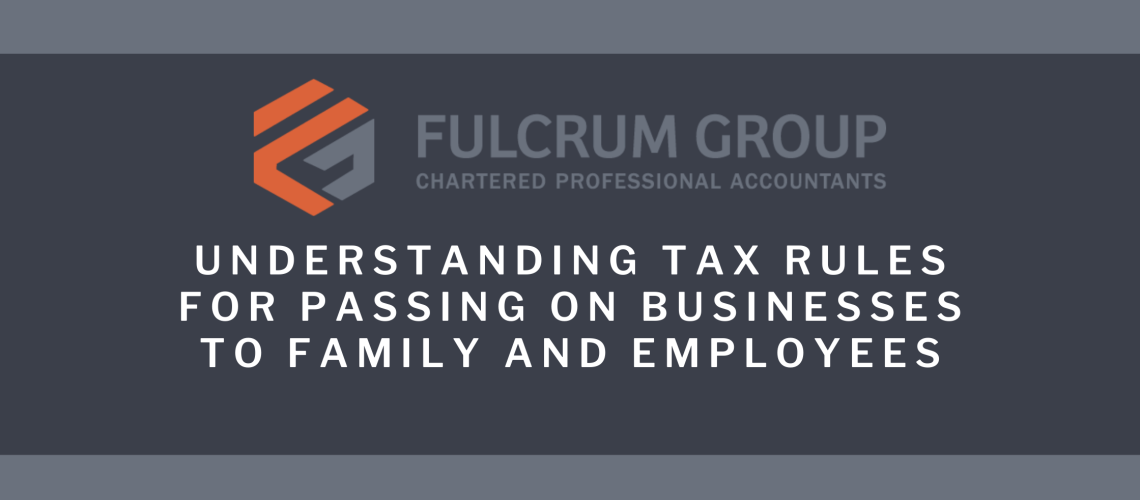Passing on businesses to family members or employees in Canada has historically come with tax challenges. Budget 2023 introduced new tax rules to address these issues, making it easier for business owners to transfer their businesses. This post aims to explain these changes in simple terms and how they might affect business succession from 2024 onwards.
Family Business Transfers:
Before Bill C-208, there was a tax difference between selling a business to a family member and selling it to someone unrelated. Selling to a family member could result in higher taxes due to certain rules. Bill C-208 aimed to fix this disparity by excluding certain transactions from these tax rules. Budget 2023 builds on these changes and sets conditions for a “genuine intergenerational business transfer” to qualify for tax benefits (Bruce Ball, 2023).
Budget 2023 proposes several conditions for such transfers, including immediate transfers made within 36 months and gradual transfers made over 5 to 10 years (Bruce Ball, 2023). If the conditions are met and an election is made, the transfer would be exempt from certain tax rules.
Budget 2023 also suggests other changes to simplify the process, such as eliminating the need for independent assessments and affidavits, extending timeframes for capital gains exemptions, and introducing joint and several liability for tax payment under certain circumstances (Bruce Ball, 2023).
Employee Ownership Trusts (EOTs):
Existing tax rules have made it challenging to create Employee Ownership Trusts (EOTs) in Canada (Bruce Ball, 2023). However, Budget 2023 proposes new rules to overcome these obstacles and offer a succession planning option for business owners.
An EOT involves selling a business to employees through a trust that holds the shares on their behalf. This simplifies matters compared to each employee owning shares individually.
How do Employee Ownership Trusts work?
Here is a simplified explanation of the EOT process (Bruce Ball, 2023):
- Formation: An EOT is created, and employees become beneficiaries of the trust.
- Negotiation: The trust negotiates the purchase of the business shares using debt financing.
- Repayment: The trust repays the debt over time using earnings from the business.
Budget 2023 proposes new rules to allow the creation of EOTs in Canada. The rules specify conditions for the trust’s holdings, employee eligibility, distribution limitations, and trustee appointments.
Tax Benefits of EOTs:
The proposed EOT rules offer the following tax benefits (Bruce Ball, 2023):
- No 21-year deemed disposition rule: EOTs would not be subject to a rule that triggers a taxable event every 21 years.
- Extended shareholder loan repayment period: The repayment period for certain loans would be extended to 15 years.
- Extension of capital gains reserve: Vendors could defer recognizing part of the capital gain over up to 10 years.
Future Steps:
If approved, the new tax rules for family business transfers and EOTs will come into effect from January 1, 2024 (Bruce Ball, 2023).
Conclusion:
Budget 2023 introduces important tax changes to facilitate the transfer of businesses to family members and employees. The new rules aim to promote fair transfers and simplify the establishment of EOTs as a succession planning option. While this approach focuses on removing tax barriers, it still offers a valuable alternative for business owners. By understanding these new tax rules, business owners can make informed decisions when planning for business succession in 2024 and beyond.
Stay Informed:
For assistance or further information on this topic please reach out to our office at 780-532-4641 or e-mail office@fulcrumgroup.ca.
References
Bruce Ball, FCPA, FCA, CFP (2023, May 16). Business succession — New tax rules to consider for family business transfers. Retrieved from Chartered Professional Accountants Canada: https://www.cpacanada.ca/en/business-and-accounting-resources/taxation/~/link.aspx?_id=51946591F32B45D39E7EB58FD292CF71&_z=z
Blog Post Contributed by Matthew Kozlowski, CPA



